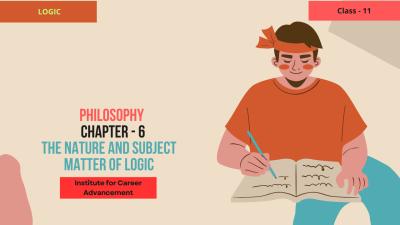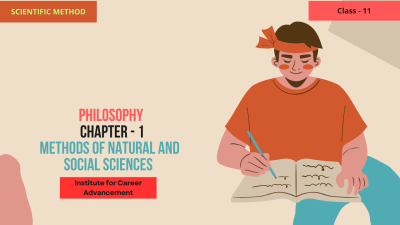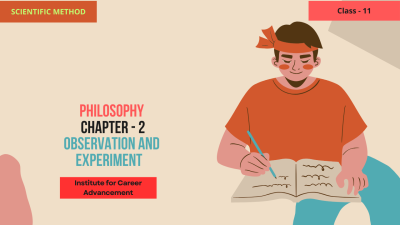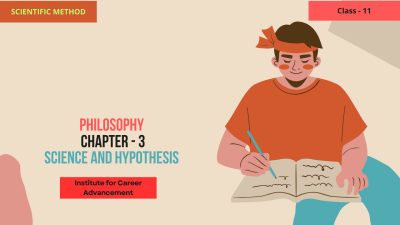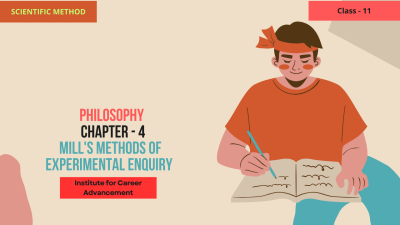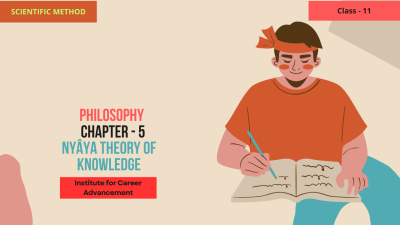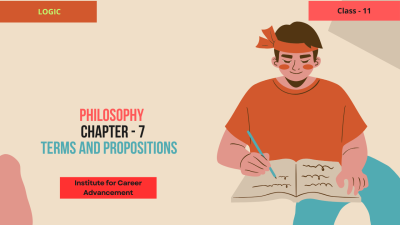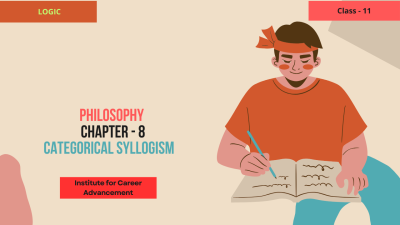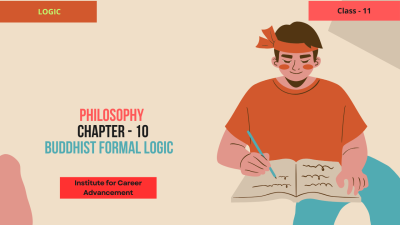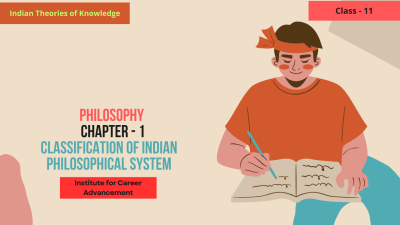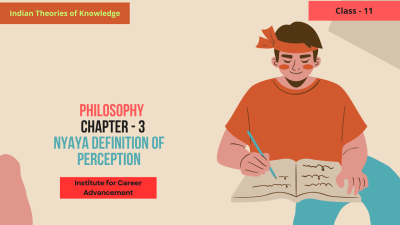Course description
The topic "The Nature and Subject Matter of Logic" in a Class 11 course generally explores the fundamental concepts of logic, which is the study of reasoning, argumentation, and principles of valid inference. The course aims to introduce students to how logical reasoning works and how it can be applied in various contexts. Here's an overview of the subject matter for Class 11:
1. Introduction to Logic
Definition of Logic: Logic is the science of reasoning that helps in determining whether an argument is valid or not. It provides a framework for evaluating reasoning and distinguishing good arguments from bad ones.
Importance of Logic: It aids in critical thinking, clear communication, and problem-solving. It is foundational for subjects like mathematics, philosophy, and computer science.
2. Types of Logic
Deductive Logic: Involves reasoning from general principles to specific conclusions. The conclusions are guaranteed to be true if the premises are true (e.g., syllogisms).
Inductive Logic: Involves reasoning from specific observations to broader generalizations. Conclusions are likely but not guaranteed.
Symbolic Logic: Uses symbols to represent logical expressions and is often used in mathematical logic and computer science.
3. The Components of Logic
Propositions: The basic building blocks of logic. A proposition is a statement that can be either true or false (e.g., "The sky is blue").
Arguments: A set of propositions where one is the conclusion, and the others are premises (reasons given to support the conclusion).
Validity: An argument is valid if the conclusion logically follows from the premises.
Soundness: An argument is sound if it is both valid and its premises are true.
4. Logical Operations
Conjunction (AND): A compound statement that is true if both individual statements are true.
Disjunction (OR): A compound statement that is true if at least one of the individual statements is true.
Negation (NOT): A statement that is the opposite of a given proposition (if the proposition is true, its negation is false, and vice versa).
Implication (IF...THEN): A statement that links a condition (premise) to a conclusion (e.g., "If it rains, then I will carry an umbrella").
5. Forms of Logical Reasoning
Syllogism: A form of deductive reasoning where a conclusion is drawn from two given or assumed propositions (premises). Example: "All humans are mortal; Socrates is a human; therefore, Socrates is mortal."
Modus Ponens (Affirming the Antecedent): A valid argument form where if "P implies Q" and "P" is true, then "Q" must be true.
Modus Tollens (Denying the Consequent): A valid argument form where if "P implies Q" and "Q" is false, then "P" must also be false.
6. Logical Fallacies
Logical fallacies are errors in reasoning that undermine the logic of an argument. Examples include ad hominem, straw man, and false dichotomy.
Students learn to identify common fallacies and understand why they are invalid.
7. Truth Tables
Truth tables are used to show the truth values of compound logical statements. These tables help in evaluating the truth or falsity of complex propositions based on the truth of individual components.
Conclusion
The study of logic in Class 11 aims to build foundational skills in reasoning, argumentation, and critical thinking. It encourages students to evaluate the structure of arguments, understand different forms of reasoning, and apply logical principles to solve problems and analyze real-world situations.
একাদশ শ্রেণির কোর্সে "দ্য নেচার অ্যান্ড সাবজেক্ট ম্যাটার অফ লজিক" বিষয়টি সাধারণত যুক্তির মৌলিক ধারণাগুলি অন্বেষণ করে, যা যুক্তি, যুক্তি এবং বৈধ অনুমানের নীতিগুলির অধ্যয়ন। যৌক্তিক যুক্তি কীভাবে কাজ করে এবং কীভাবে এটি বিভিন্ন প্রসঙ্গে প্রয়োগ করা যেতে পারে সে সম্পর্কে শিক্ষার্থীদের পরিচয় করিয়ে দেওয়া এই কোর্সের লক্ষ্য। এখানে একাদশ শ্রেণির বিষয়ের একটি সংক্ষিপ্ত বিবরণ দেওয়া হলঃ
1টি। যুক্তির পরিচিতি
যুক্তির সংজ্ঞাঃ যুক্তি হল যুক্তির বিজ্ঞান যা কোনও যুক্তি বৈধ কিনা তা নির্ধারণে সহায়তা করে। এটি যুক্তির মূল্যায়ন এবং খারাপ থেকে ভাল যুক্তিগুলি আলাদা করার জন্য একটি কাঠামো সরবরাহ করে।
যুক্তির গুরুত্বঃ এটি সমালোচনামূলক চিন্তাভাবনা, স্পষ্ট যোগাযোগ এবং সমস্যা সমাধানে সহায়তা করে। এটি গণিত, দর্শন এবং কম্পিউটার বিজ্ঞানের মতো বিষয়গুলির ভিত্তি।
2. যুক্তির প্রকার
ডিডাক্টিভ লজিকঃ সাধারণ নীতি থেকে নির্দিষ্ট সিদ্ধান্তে যুক্তি অন্তর্ভুক্ত করে। যদি ভিত্তিটি সত্য হয় তবে উপসংহারগুলি সত্য হওয়ার নিশ্চয়তা দেওয়া হয়। (e.g., syllogisms).
ইন্ডাক্টিভ লজিকঃ নির্দিষ্ট পর্যবেক্ষণ থেকে বৃহত্তর সাধারণীকরণ পর্যন্ত যুক্তিকে অন্তর্ভুক্ত করে। উপসংহারের সম্ভাবনা আছে কিন্তু নিশ্চয়তা নেই।
প্রতীকী যুক্তিঃ যৌক্তিক অভিব্যক্তি উপস্থাপন করতে প্রতীক ব্যবহার করে এবং প্রায়শই গাণিতিক যুক্তি এবং কম্পিউটার বিজ্ঞানে ব্যবহৃত হয়।
3. যুক্তির উপাদানসমূহ
প্রস্তাবনাঃ যুক্তির মৌলিক ভিত্তি। প্রস্তাব হল এমন একটি বিবৃতি যা সত্য বা মিথ্যা হতে পারে। (e.g., "The sky is blue").
যুক্তিঃ প্রস্তাবের একটি সেট যেখানে একটি উপসংহার, এবং অন্যগুলি ভিত্তি (reasons given to support the conclusion).
বৈধতাঃ একটি যুক্তি বৈধ যদি উপসংহারটি যৌক্তিকভাবে প্রাঙ্গণ থেকে অনুসরণ করে।
দৃঢ়তাঃ একটি যুক্তি যদি বৈধ হয় এবং এর ভিত্তি উভয়ই সত্য হয় তবে তা সঠিক।
4. যৌক্তিক ক্রিয়াকলাপ
সংযোগ (AND) একটি যৌগিক বিবৃতি যা সত্য যদি উভয় পৃথক বিবৃতি সত্য হয়।
বিচ্ছিন্নতা (OR) একটি যৌগিক বিবৃতি যা সত্য যদি পৃথক বিবৃতিগুলির মধ্যে অন্তত একটি সত্য হয়।
নেতিবাচক (না) একটি বিবৃতি যা একটি প্রদত্ত প্রস্তাবের বিপরীত (if the proposition is true, its negation is false, and vice versa).
ইম্প্লিকেশন (যদি... তারপর) একটি বিবৃতি যা একটি শর্ত (ভিত্তি) একটি উপসংহারের সাথে সংযুক্ত করে (e.g., "If it rains, then I will carry an umbrella").
5. যৌক্তিক যুক্তির ধরন
সিলেজিজমঃ অনুমানমূলক যুক্তির একটি রূপ যেখানে দুটি প্রদত্ত বা অনুমিত প্রস্তাব থেকে একটি উপসংহার টানা হয়। (premises). উদাহরণস্বরূপঃ "সকল মানুষই মরণশীল; সক্রেটিস একজন মানুষ; অতএব সক্রেটিস মরণশীল।"
মোডাস পোনেনস (পূর্বপুরুষকে নিশ্চিত করা) একটি বৈধ আর্গুমেন্ট ফর্ম যেখানে যদি "পি মানে কিউ" এবং "পি" সত্য হয়, তবে "কিউ" অবশ্যই সত্য হতে হবে।
মোডাস টলেনস (পরিণতি অস্বীকার করা) একটি বৈধ আর্গুমেন্ট ফর্ম যেখানে যদি "পি বোঝায় কিউ" এবং "কিউ" মিথ্যা হয়, তবে "পি" অবশ্যই মিথ্যা হতে হবে।
6টি। যৌক্তিক ভুলত্রুটি
যৌক্তিক ভ্রান্তিসমূহ হল যুক্তির ত্রুটি যা একটি যুক্তির যুক্তিকে দুর্বল করে দেয়। উদাহরণের মধ্যে রয়েছে অ্যাড হোমিনেম, স্ট্র ম্যান এবং ফলস ডাইকোটমি।
শিক্ষার্থীরা সাধারণ ভুলগুলি সনাক্ত করতে এবং সেগুলি কেন অকার্যকর তা বুঝতে শেখে।
7. সত্যের টেবিল
যৌগিক যৌক্তিক বিবৃতির সত্য মান দেখানোর জন্য সত্য সারণি ব্যবহার করা হয়। এই টেবিলগুলি পৃথক উপাদানগুলির সত্যতার উপর ভিত্তি করে জটিল প্রস্তাবগুলির সত্য বা মিথ্যা মূল্যায়ন করতে সহায়তা করে।
উপসংহার
একাদশ শ্রেণিতে যুক্তি অধ্যয়নের লক্ষ্য হল যুক্তি, যুক্তি এবং সমালোচনামূলক চিন্তাভাবনার ক্ষেত্রে মৌলিক দক্ষতা গড়ে তোলা। এটি শিক্ষার্থীদের যুক্তির কাঠামো মূল্যায়ন করতে, বিভিন্ন ধরনের যুক্তি বুঝতে এবং সমস্যা সমাধানের জন্য যৌক্তিক নীতি প্রয়োগ করতে এবং বাস্তব-বিশ্বের পরিস্থিতি বিশ্লেষণ করতে উৎসাহিত করে।

